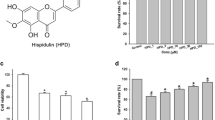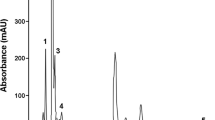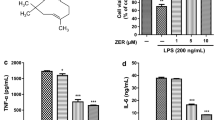Abstract
Microglia is the resident innate immune cells that sense pathogens and tissue injury in the central nervous system. Microglia becomes activated in response to injury, infection, and other stimuli that threaten neuronal survival. Microglia activation plays an important role in neurodegenerative diseases. Neochlorogenic acid (NCA) is a natural polyphenolic compound found in dried fruits and other plants. Although previous studies have shown that phenolic acids including NCA have outstanding antioxidant, antibacterial, antiviral, and antipyretic activities, there has not yet been investigated for anti-inflammatory effects. Therefore, for the first time we have examined the potential of NCA to inhibit microglial activation and pro-inflammatory responses in the brain. We found that lipopolysaccharide-induced inducible nitric oxide synthase, and cyclooxygenase-2 expression, and nitric oxide formation was suppressed by NCA in a dose-dependent manner in BV2 microglia. NCA also inhibited the production of pro-inflammatory mediators, tumor necrosis factor-α and interleukin-1 beta. Furthermore, phosphorylated nuclear factor-kappa B p65 and p38 mitogen-activated protein kinase activation were blocked by NCA. Taken together, these results suggest that NCA exerts neuroprotective effects through the inhibition of pro-inflammatory pathways in activated microglia.





Similar content being viewed by others
References
Aguzzi A, Barres BA, Bennett ML (2013) Microglia: Scapegoat, saboteur, or something else? Science 339:156–161
Block ML, Zecca L, Hong JS (2007) Microglia-mediated neurotoxicity: uncovering the molecular mechanism. Nat Rev Neurosci 8:57–69
Nimmerjahn A, Kirchhoff F, Helmchen F (2005) Resting microglial cells are highly dynamic surveillants of brain parenchyma in vivo. Science 308:1314–1318
Ock J, Han HS, Hong SH, Lee SY, Han YM, Kwon BM, Suk K (2010) Obovatal attenuates microglia-mediated neuroinflammation by modulating redox regulation. Br J Pharmacol 159:1646–1662
Perry VH, Nicoll JA, Holmes C (2010) Microglia in neurodegenerative disease. Nat Rev Neurol 6:193–201
Rivest S (2003) Molecular insights on the cerebral innate immune system. Brain Behav Immun 17:13–19
Das S, Basu A (2008) Inflammation: a new candidate in modulating adult neurogenesis. J Neurosci Res 86:1199–1208
Lue LF, Kuo YM, Beach T, Walker DG (2010) Microglia activation and anti-inflammatory regulation in Alzheimer’s disease. Mol Neurobiol 41:115–128
Long-Smith CM, Sullivan AM, Nolan YM (2009) The influence of microglia on the pathogenesis of Parkinson’s disease. Prog Neurobiol 89:227–287
Glass CK, Saijo K, Winner B, Matchetto MC, Gage FH (2010) Mechanisms underlying inflammation in neurodegeneration. Cell 140:918–934
Infante R, Contador L, Rubil P, Aros D, Pena-Neira Á (2011) Postharvest sensory and phenolic characterization of ‘Elegant Lady’ and ‘Carson’ peaches. Chil J Agric Res 71:445–451
Chen Y, Li SG, Lin XH, Luo HB, Li GG, Yao H (2008) On-line screening and identification of radical scavenging compounds extracted from Flos Lonicerae by LC-DAD-TOF-MS. Chromatographia 68:327–333
Hung XM, Na M, Thuong PT, Su NA, Sok D, Song KS, Seong YH, Bae K (2006) Antioxidant activity of caffeoyl quinic acid derivatives from the roots of Dipsacus asper Wall. J Ethnopharmacol 108:188–192
Mishima S, Yoshida C, Akino S, Sakamoto T (2005) Antihypertensive effects of Brazillian propolis: identification of caffeoylquinic acids as constituents involved in the hypotension in spontaneously hypertensive rats. Biol Pharm Bull 28:1909–1914
Koo HJ, Lim KH, Jung HJ, Park EH (2006) Anti-inflammatory evaluation of gardenia extract, geniposide and genipin. J Ethnopharmacol 103:496–500
Korhnen R, Lahti A, Hämäläinen M, Kankaanranta H, Moilanen E (2002) Dexamethasone inhibits inducible nitric-oxide synthase expression and nitric oxide production by destabilizing mRNA in lipopolysaccharide-treated macrophages. Mol Pharmacol 62:698–704
Liu B, Hong J-s (2003) Role of microglia in inflammation-mediated neurodegenerative diseases: mechanisms and strategies for therapeutic intervention. J Pharmacol 304:1–7
Minghetti L, Levi G (1998) Microglia as effector cells in brain damage and repair: focus on prostanoids and nitric oxide. Prog Neurobiol 54:99–125
Rivest S (2011) The promise of anti-inflammatory therapies for CNS injuries and diseases. Expert Rev Neurother 11:783–786
Murphy S (2000) Production of nitric oxide by glial cells: regulation and potential roles in the CNS. Glia 29:1–13
Brown GC, Borutaite V (2002) Nitric oxide inhibition of mitochondrial respiration and its role in cell death. Free Radic Biol Med 33:1440–1450
Minghetti L (2004) Cyclooxygenase-2 (COX-2) in inflammatory and degenerative brain diseases. J Neuropathol Exp Neurol 63:901–910
Merson TD, Binder MD, Kilpatrik TJ (2010) Role of cytokines as mediators and regulators of microglia activity in inflammatory demylination of the CNS. Neuromol Med 12:99–132
Hoozemans JJ, Veerhuis R, Rozemuller JM, Eikelenboom P (2006) Neuroinflammation and regeneration in the early stages of Alzheimer’s disease pathology. Int J Dev Neurosci 24:157–165
Inoue K (2006) The function of microglia through purinergic receptors: neuropathic pain and cytokines release. Pharmacol Ther 109:210–226
He FQ, Qiu BY, Zhang XH, Li TK, Xie Q, Cui DJ et al (2011) Tetrandrine attenuates spatial memory impairment and hippocampal neuroinflammation via inhibiting NF-κB activation in a rat model of Alzheimer’s disease induced by amyloid-β (1–42). Brain Res 1384:89–96
Yeo SJ, Yoo JG, Yi AK (2003) Myeloid differentiation factor 88-dependent post-necrosis factor-alpha receptor- associated factor 6, a diverging point in the Toll-like receptor 9-signaling. J Biol Chem 278:40590–40600
Vallabhapurapu S, Karin M (2009) Regulation and function of NF-kappaB transcription factors in the immune system. Annu Res Immunol 27:693–733
Kaminska B, Gozdz A, Zawadzka M, Ellert-Miklaszewska A, Lipko M (2009) MAPK signal transduction underlying brain inflammation and gliosis as therapeutic target. Anat Rec 292:1902–1913
Krementsov DN, Thornton TM, Teuscher C, Rincon M (2013) The emerging role of p38 mitogen-activated protein kinase in multiple sclerosis and its models. Mol Cell Biol 33:3728–3734
Branger J, van den Blink B, Weijer S, Madwed J, Bos CL et al (2006) Anti-inflammatory effects of a p38 mitogen-activated protein kinase inhibitor during human endotoxemia. J Immunol 168:4070–4077
Ashwell JD (2006) The many paths to p38 mitogen-activated protein kinase activation in the immune system. Nat Rev Immunol 6:532–540
Acknowledgments
This study was supported by the Korea Food Research Institute.
Author information
Authors and Affiliations
Corresponding author
Ethics declarations
Conflict of interest
The authors declare that they have no conflict of interest.
Human and animal rights
This article does not contain any studies with human participants or animals performed by any of the authors.
Rights and permissions
About this article
Cite this article
Kim, M., Choi, SY., Lee, P. et al. Neochlorogenic Acid Inhibits Lipopolysaccharide-Induced Activation and Pro-inflammatory Responses in BV2 Microglial Cells. Neurochem Res 40, 1792–1798 (2015). https://doi.org/10.1007/s11064-015-1659-1
Received:
Revised:
Accepted:
Published:
Issue Date:
DOI: https://doi.org/10.1007/s11064-015-1659-1




